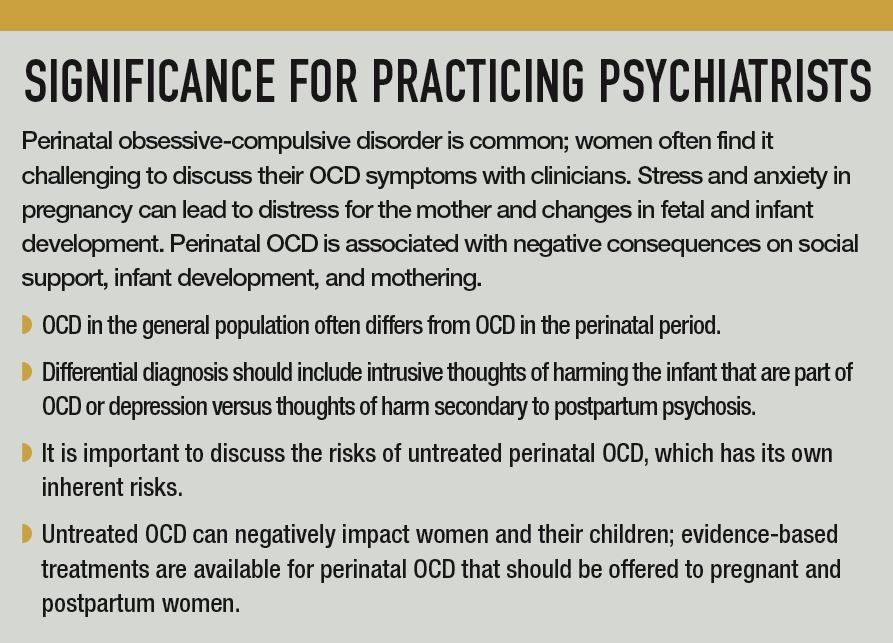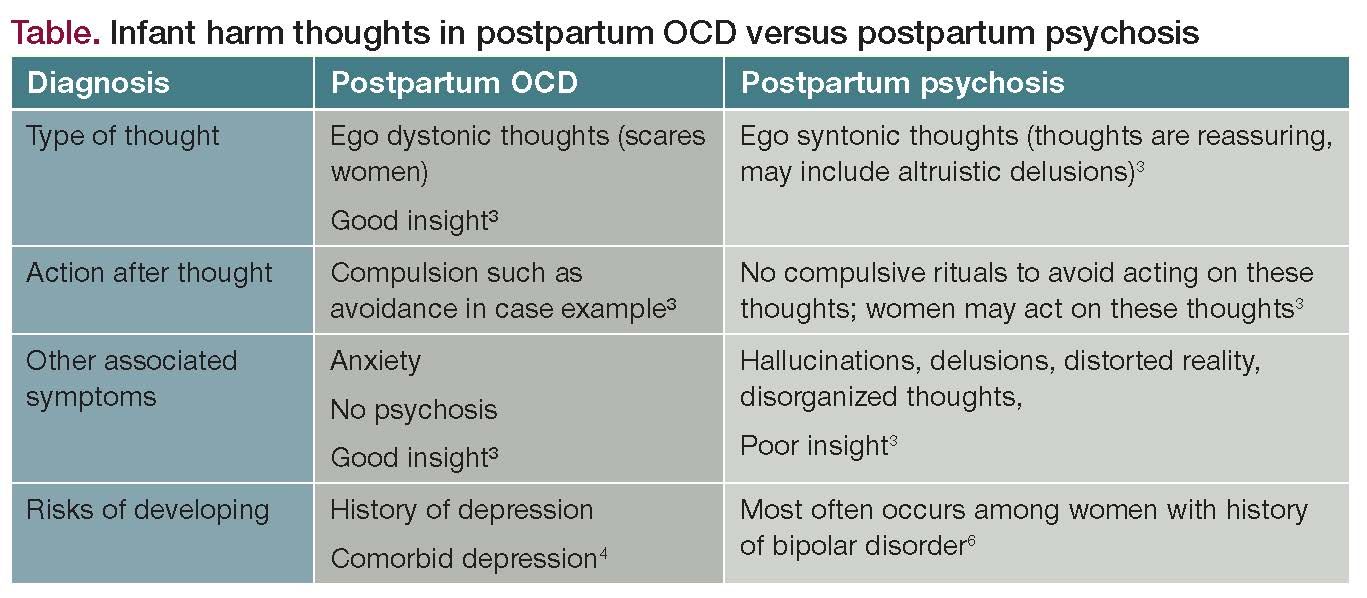When Baby and OCD Are on Board Assessment and Treatment Issues
OCD in the general population often differs from OCD that presents in the perinatal period. It is imperative to recognize, assess, and treat perinatal OCD to improve maternal and child outcomes and have a transgenerational impact.

Significance for practicing psychiatrists

Table. Infant harm thoughts in postpartum OCD versus postpartum psychosis

CASE VIGNETTE
“Andrea,” a 28 year old is 6 months postpartum. She presents to the psychiatric department (ED) seeking help for anxiety. She notes that she was reluctant to come to the ED because of fear of being judged, yet ultimately came because her husband has noticed that she is spending less and less time with the baby and he is becoming increasingly worried about her.
Andrea reports that she has been having thoughts of drowning her child since she was 1 month postpartum. She has been avoiding washing dishes for fear that she will spray the water on her baby and cause her harm. She does not want to harm her child, and reports these thoughts are scary and distressing, but she cannot get the drowning images out of her head. The thoughts are frequent and can persist for up to 4 or 5 hours every day. She is so worried that she will act on these thoughts that she has been asking her mother or her partner to bathe her daughter, and she is relieved not to have to do it herself. Aside from adapting to life with a newborn, she reports no other major current stressors and appreciates the support from her husband and her parents.
On psychiatric review of symptoms, she does not endorse current mood symptoms. She has a history of depression; in her first year of college she was treated with fluoxetine and completed a course of cognitive behavioral therapy, after which the symptoms resolved. She stopped fluoxetine 6 months later and has felt well since then.
She has no history of harming herself or others and no other psychiatric history, including no history of obsessive compulsive disorder. She reports significant anxiety and feeling on edge often because of the thoughts of drowning her baby. Aside from recent non-complicated vaginal delivery, her medical history is also significant for hypothyroidism, for which she continues to take levothyroxine.
Prevalence and epidemiology
Perinatal (ie, pregnancy or in the year after birth) obsessive-compulsive disorder (OCD) is common, with a prevalence of 2% during pregnancy and 2.5% in the postpartum period.1 In perinatal OCD, the onset of OCD symptoms is during pregnancy or the postpartum period. Subthreshold OCD symptoms that can involve intrusive thoughts about harming the newborn or fetus also are prevalent, and prior research reports that 49% to 69% of women have such thoughts during the perinatal period.2
OCD in the general population often differs from OCD that presents in the perinatal period. In perinatal OCD, most obsessions involve the fetus or newborn, and the obsessions are often accompanied by intrusive thoughts and fears of harming the newborn. Compulsions often manifest as avoidance of the newborn or things related to their obsessions (eg, water, in the Andrea’s case).3 Similarly, women who develop OCD during pregnancy tend to have contamination obsessions and rituals such as washing and cleaning. To meet the diagnostic criteria for OCD, the symptoms need to be severe enough to cause impairment.
When the onset of OCD symptoms occurs postpartum, it tends to occur rapidly, usually beginning within 4 weeks postpartum. Symptoms can also start during pregnancy, although usually the onset is more gradual if occurring during the prenatal period as compared to during the postpartum period.3
Risk factors
Risk factors for perinatal OCD include personal history of depression, primiparity, obsessive-compulsive personality disorder, avoidant personality disorder, obstetric complications during pregnancy or delivery, and somatic illness. Family history of mood and substance use disorders are more common than family history of obsessive-compulsive disorder in women with perinatal OCD.4
Detection and assessment
Many women with perinatal OCD are hesitant to disclose symptoms to medical providers due to stigma and concerns about child protective services. It is important to approach women using an empathic strength-based approach and to ask specifically about intrusive thoughts. Women may prefer to discuss intrusive thoughts in general without revealing specific details. Asking how they are managing the thoughts can help facilitate the assessment, because women may be more comfortable discussing it when approached in this manner. For example, stating “This sounds so stressful and scary, how are you managing to spend time with your baby with all this happening?” instead of “Why have you not been spending time with your baby?”5
Women with OCD are at low risk of acting on intrusive thoughts because, as in Andrea’s case, the thoughts of harming their newborns are ego dystonic and scare women, thus they have no intention of harming their newborn. Given this, referral to child protective services or referral the psychiatric emergency room is not usually necessary. If done inappropriately, such referrals can be perceived as punitive by women and their families, exacerbating OCD symptoms and creating barriers for participating in outpatient mental health treatment.5
Diagnosis and comorbidity
Women with postpartum OCD often have obsessional thoughts around harming their child, which can be scary for both the patient and their health care provider(s). As previously noted, patients with OCD do not typically act on their intrusive thoughts. It is important to differentiate intrusive thoughts of harming the infant that are part of OCD or depression versus thoughts of harm secondary to postpartum psychosis (Table). Postpartum psychosis is ego syntonic and often is associated with hallucinations, delusions, and negative symptoms of psychosis such as disorganization and changes in mood that are not seen in OCD.3 Postpartum psychosis is rare but is considered a psychiatric emergency and occurs most frequently in women with bipolar disorder.6
Women with perinatal OCD are at higher risk of depression, especially significant when intrusive thoughts about hurting the newborn are present. Many women with perinatal OCD also develop depression, and obsessions are common within perinatal depression as well.3
CASE VIGNETTE, CONTINUED
After a full assessment, the psychiatrist in the ED diagnoses perinatal OCD. The psychiatrist provides psychoeducation and reassures Andrea that the risks of harming her baby are low and that what she is having are intrusive thoughts that are common in OCD. The psychiatrist talks to Andrea about various treatment options, including exposure response prevention therapy (a type of cognitive behavioral therapy) and medication options. Andrea is eager to start exposure response prevention therapy.
Andrea, however, is much more cautious about medications, despite her severe symptoms, because she is currently breastfeeding. She reports she has talked to friends who were told that medications were too risky throughout the perinatal period and when breastfeeding and would like to know more about the risks and benefits of medications prior to starting one. She said that she has several friends who were told that they needed to stop their medications immediately after getting pregnant and could not start them again until after they finished breastfeeding, and she worries about the risks.
Treatment issues
A patient-centered approach is important for the treatment of OCD, and both the provider and patient should feel comfortable with the plan. Cognitive behavioral therapy either alone or with selective serotonin reuptake inhibitor (SSRI) medications is effective and should be offered. SSRIs alone can also be effective. In cases of treatment-resistant OCD in the perinatal period, when treatment with SSRI medication or serotonin norepinephrine reuptake inhibitors (SNRIs) has not been effective, augmentation with quetiapine also has been shown to be effective.7
When leveraging pharmacotherapy, it is important to discuss the risks and benefits of the medications during the perinatal period, which includes potential effects to the fetus if the woman is pregnant and effects in postpartum if the woman is breastfeeding. When discussing medications, it also is important to discuss the risks of untreated perinatal OCD, which carries risk in itself. Stress and anxiety in pregnancy can lead to distress for the mother and can lead to changes in fetal and infant development. Perinatal OCD has been associated with negative consequences on social support, infant development, and mothering.8
During pregnancy, antidepressants are an evidence-based treatment option and are not considered major teratogens.9 When considering medications in the postnatal period, if a woman is breastfeeding, it is important to also discuss that breastfeeding is considered generally safe with low blood levels of SSRIs passed through the breastmilk.9 When considering a medication, it is important to consider what has and has not been helpful to the woman in the past to avoid multiple exposures and medication trials. There are many databases that can be helpful for information on medications during the perinatal period for patients and clinicians who have more questions, including databases such as MotherToBaby,10 Lactmed,11 and ReproTox.12
Conclusion
Given its prevalence and it negative impact when left untreated, it is imperative to recognize, assess, and treat perinatal OCD using a strength-based approach. Doing so carries the potential to improve maternal and child outcomes and have a transgenerational impact.
Disclosures:
Dr Kucherer is Assistant Professor of Psychiatry at the University of Pittsburgh Medical Center, Western Psychiatric Hospital. Dr. Byatt is Associate Professor of Psychiatry at University of Massachusetts Medical School. Dr Kucherer has nothing to disclose regarding the subject matter of this piece. Dr Byatt has served on the Medscape Steering Committee on Clinical Advances in Postpartum Depression. She has received honoraria from Medscape and Miller Medical Communications. She has served on Advisory Boards for Sage Therapeutics, and is a Council Member of the Gerson Lehrman Group. She also has served as a consultant for Ovia Health, Sage Therapeutics or their agents, and has received speaking honoraria from Sage Therapeutics.
References:
1. Davies, SC. Perinatal mental health. In Annual report of the Chief Medical Officer, 2014. The health of the 51%: Women. London, UK: Department of Health;2015.
2. FrÃas, Ã, Palma, C, Barón, F, et al. Obsessive-compulsive disorder in the perinatal period: Epidemiology, phenomenology, pathogenesis, and treatment. Anales De PsicologÃa/Annals of Psychology. 2015;31(1):1-7.
3. Buchholz, JL, Hellberg, SN, & Abramowitz, JS. Phenomenology of perinatal obsessive-compulsive disorder. In Biomarkers of Postpartum Psychiatric Disorders. Academic Press. 2020; 79-93.
4. Sharma, V, & Sommerdyk, C. Obsessive–compulsive disorder in the postpartum period: diagnosis, differential diagnosis and management. Women’s Health. 2015;11(4):543-552.
5. Challacombe, FL., Bavetta, M, DeGiorgio, S. Intrusive thoughts in perinatal obsessive-compulsive disorder. BMJ. 2019;367.
6. Lewis KJ, Di Florio A, Forty L, et al. Mania triggered by sleep loss and risk of postpartum psychosis in women with bipolar disorder. Journal Affect Disord, 2018;225: 624-629.
7. Marchesi C, Ossola P, Amerio A, et al. Clinical management of perinatal anxiety disorders: A systematic review. Journal Affect Disord. 2016;190:543-550.
8. Collardeau F, Corbyn B, Abramowitz J, et al. Maternal unwanted and intrusive thoughts of infant-related harm, obsessive-compulsive disorder and depression in the perinatal period: study protocol. BMC psychiatry. 2019;19(1):94.
9. Payne JL. Psychopharmacology in pregnancy and breastfeeding. Psychiatric Clinics. 2017;40(2): 217-238.
10. Organization of Teratology Information Specialists. MotherToBaby Fact sheets. https://mothertobaby.org/fact-sheets-parent/. Accessed January 30, 2020.
11. National Library of Medicine (US). Drugs and Lactation Database (LactMed). www.ncbi.nlm.nih.gov/books/NBK501922/. Accessed January 30, 2020.
12. Reproductive Toxicology Center. Reprotox. https://www.reprotox.org/. Accessed February 3, 2020.

